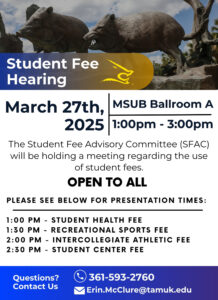When walking around Texas A&M University-Kingsville (TAMUK), it can be difficult to imagine a time when Hispanics were discriminated against on campus, particularly during Hispanic Heritage Month when their contributions are being recognized. However, this was the reality for minority students on campus for more than 40 years.
Like many cities in the southern United States, Kingsville was segregated and the community was controlled by the Anglos. The lack of Hispanic representation in positions of power was reflected in the university, which was known as Texas A&I University at the time.
On the Texas A&I campus, Hispanic students were discriminated against in many ways for decades. For example, they were often placed to live-in dorms on campus with no air condition, they were not allowed to join any Greek organizations on campus, and they were not given equal treatment in school elections for student government. This was all set to change in the mid-1960s when Chicano students began to protest for equal rights.
In U.S. history, the 1960s are known as a time of revolution as minorities began to fight for the rights awarded to them in the constitution. At this same time, Hispanic students at Texas A&I were beginning to question the discrimination they were facing at the university. Pulling inspiration from the civil right movements happening nationally, Roberto Villarreal, a political activist in Kleberg County, said in an interview with Nicole Morris that Chicano students of Texas A&I “decided that they would not just accept the situation and took action to change the system.”
José Ángel Gutiérrez and Carlos Guerra were two important figures in the Chicano movement at the Texas A&I campus. On campus, they began to organize Hispanic students who wanted a change. Thus, began the Chicano movement at the university.
Chicano is defined as “of or relating to Mexican-Americans or their culture,” according to dictionary.com. However, since the 1960s, the word has been used to describe Mexican-American activist who fight for equal rights.
Chicanos on campus focused on ending discrimination at the university. They did this by advocating for the rights of Chicano janitorial, landscape and cafeteria employees. Their campaigns also hoped to gain more Hispanic representation in the Student Government Association (SGA), the Activities Governing Board, The South Texan, the university yearbook and the beauty pageants held on campus.
“We began to change the make-up of these bodies by adding seats, such as seats for the off-campus students, dorm students and other clubs. This reform was augmented by our constitutional challenge to the method of elections, from requiring a majority vote to a plurality vote. We began bloc voting and winning,” Gutiérrez said in his book The Making of a Chicano Militant.
Along with fighting for representation, Chicanos also wanted to end the English proficiency test students had to pass because the exam would often prevent Hispanic students from graduating. Chicanos felt that this undermined their intelligence and was just another form of discrimination to prevent Hispanics from being successful.
Dr. Manuel Flores is currently a communications professor at TAMUK, but was a reporter for The South Texan as a student from 1966 through 1970. He recounted his experience as a student during the 1960s and how professors would treat Hispanics differently than their Anglo peers.
“It was tough when you went into the classrooms, it was very hard. Some professors did not want to teach you; they wouldn’t give you an A for anything. Or if you surprised them and were good they would say stuff like ‘Wow, you’re smart,’ [and] it was insulting,” Flores said.
In order to accomplish their agenda, Chicanos on campus would organize protests and publish underground newspapers such as The Rag(e) where they would call for an end to the blatant mistreatment of Hispanics. Through their determination, Chicanos on campus gradually accomplished their goals as Hispanics began to be elected as representatives in SGA and Latina women were crowned in university pageants.
As Texas A&I Chicano students began to graduate, they took their activism experiences with them and began to lead Chicano movements across South Texas and the nation. And, while TAMUK may sometimes be overlooked in Chicano history, the impact Chicanos from the university had on the movement led to the inclusive environment in which TAMUK has today.

Having been a student in the post-Chicano activist Texas A&I / TAMUK (Class of 1996); I am grateful for the leadership and conviction of these students. Their fight for equality of access and opportunity made a difference and their perseverance shouldn’t be forgotten. America’s long history of racial division and tension has come a long way but has a long way to go. Articles like these serve as strong reminders of how far we have come and keep our eyes on a better future. Maybe The South Texan should consider having a periodic campus history column to help foster these sentiments? Good work @SouthTexan, keep it up!